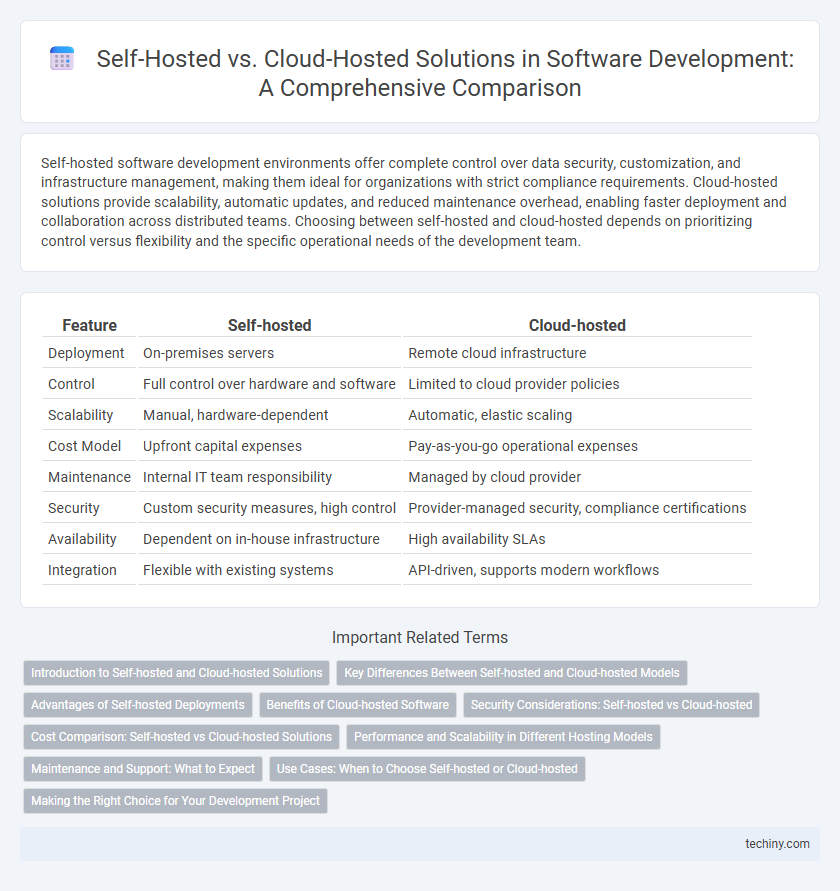Self-hosted software development environments offer complete control over data security, customization, and infrastructure management, making them ideal for organizations with strict compliance requirements. Cloud-hosted solutions provide scalability, automatic updates, and reduced maintenance overhead, enabling faster deployment and collaboration across distributed teams. Choosing between self-hosted and cloud-hosted depends on prioritizing control versus flexibility and the specific operational needs of the development team.
Table of Comparison
| Feature | Self-hosted | Cloud-hosted |
|---|---|---|
| Deployment | On-premises servers | Remote cloud infrastructure |
| Control | Full control over hardware and software | Limited to cloud provider policies |
| Scalability | Manual, hardware-dependent | Automatic, elastic scaling |
| Cost Model | Upfront capital expenses | Pay-as-you-go operational expenses |
| Maintenance | Internal IT team responsibility | Managed by cloud provider |
| Security | Custom security measures, high control | Provider-managed security, compliance certifications |
| Availability | Dependent on in-house infrastructure | High availability SLAs |
| Integration | Flexible with existing systems | API-driven, supports modern workflows |
Introduction to Self-hosted and Cloud-hosted Solutions
Self-hosted solutions involve hosting software on in-house servers, providing greater control over data security, customization, and compliance with organizational policies. Cloud-hosted solutions leverage third-party providers like AWS, Azure, or Google Cloud to deliver scalable, on-demand resources without the need for physical infrastructure management. Choosing between self-hosted and cloud-hosted options depends on factors such as budget constraints, IT expertise, scalability requirements, and the need for data sovereignty.
Key Differences Between Self-hosted and Cloud-hosted Models
Self-hosted software requires on-premises hardware and direct management of infrastructure, offering greater control and customization options. Cloud-hosted models leverage third-party data centers, providing scalable resources, automatic updates, and reduced maintenance overhead. Security responsibilities differ significantly; self-hosted demands in-house protocols while cloud-hosted relies on provider compliance with industry standards.
Advantages of Self-hosted Deployments
Self-hosted deployments offer superior control over security configurations and data privacy, allowing organizations to comply with strict regulatory requirements more effectively. They provide customizable infrastructure tailored to specific performance needs, reducing dependence on internet connectivity and potential cloud service outages. Cost efficiency over time is achievable by eliminating recurring cloud subscription fees and enabling optimal resource allocation based on actual usage.
Benefits of Cloud-hosted Software
Cloud-hosted software offers scalable resource allocation, enabling businesses to efficiently handle fluctuating workloads and reduce infrastructure costs. It provides enhanced accessibility through internet connectivity, allowing remote teams to collaborate seamlessly with real-time updates and centralized data management. Security features such as automated backups, regular updates, and advanced threat detection minimize risks compared to traditional self-hosted solutions.
Security Considerations: Self-hosted vs Cloud-hosted
Self-hosted software offers organizations full control over security measures, enabling tailored firewall configurations, data encryption protocols, and direct access management, but requires significant internal expertise and resource investment. Cloud-hosted solutions provide advanced, provider-managed security features including automated updates, threat detection, and compliance certifications like ISO 27001, yet introduce risks related to multi-tenant environments and data sovereignty. Evaluating security trade-offs involves assessing vulnerability exposure, incident response capabilities, and regulatory requirements specific to the business context.
Cost Comparison: Self-hosted vs Cloud-hosted Solutions
Self-hosted solutions entail upfront costs including hardware procurement, maintenance, and dedicated IT staff, often resulting in higher initial capital expenditure. Cloud-hosted solutions operate on a subscription or pay-as-you-go pricing model, reducing upfront investments and offering scalable cost management based on usage. Evaluating total cost of ownership (TCO) requires analyzing long-term operational expenses, including upgrades, security, and downtime risks associated with both hosting models.
Performance and Scalability in Different Hosting Models
Self-hosted software enables direct control over performance tuning by leveraging dedicated on-premises resources, resulting in predictable latency and high-speed processing tailored to specific hardware configurations. Cloud-hosted solutions offer elastic scalability, dynamically allocating computing power and storage to accommodate fluctuating workloads without upfront infrastructure investment. The choice between self-hosted and cloud-hosted models affects application responsiveness and scaling efficiency, with cloud environments excelling in rapid resource expansion while self-hosted setups provide consistent performance for stable demands.
Maintenance and Support: What to Expect
Self-hosted software requires dedicated in-house teams for regular maintenance, updates, and troubleshooting, often leading to higher operational complexity and cost. Cloud-hosted solutions offer managed support with automatic updates and 24/7 monitoring, reducing the burden on internal IT resources. Expect faster resolution times and enhanced security patches with cloud-hosted services compared to self-hosted environments.
Use Cases: When to Choose Self-hosted or Cloud-hosted
Self-hosted software suits organizations with strict data security requirements, custom integration needs, or limited internet access, offering full control over infrastructure and compliance. Cloud-hosted solutions excel in scalability, remote collaboration, and reduced maintenance costs, ideal for startups or businesses with fluctuating workloads. Evaluating factors such as budget, technical expertise, and regulatory compliance guides the choice between self-hosted and cloud-hosted environments.
Making the Right Choice for Your Development Project
Choosing between self-hosted and cloud-hosted environments depends on factors such as control, scalability, security, and budget constraints within your software development project. Self-hosted solutions offer greater customization and data privacy by maintaining infrastructure in-house, while cloud-hosted platforms provide flexible resource management and reduced upfront costs. Assessing project requirements related to compliance, expected traffic loads, and long-term maintenance is crucial for selecting the optimal hosting strategy.
Self-hosted vs Cloud-hosted Infographic

 techiny.com
techiny.com